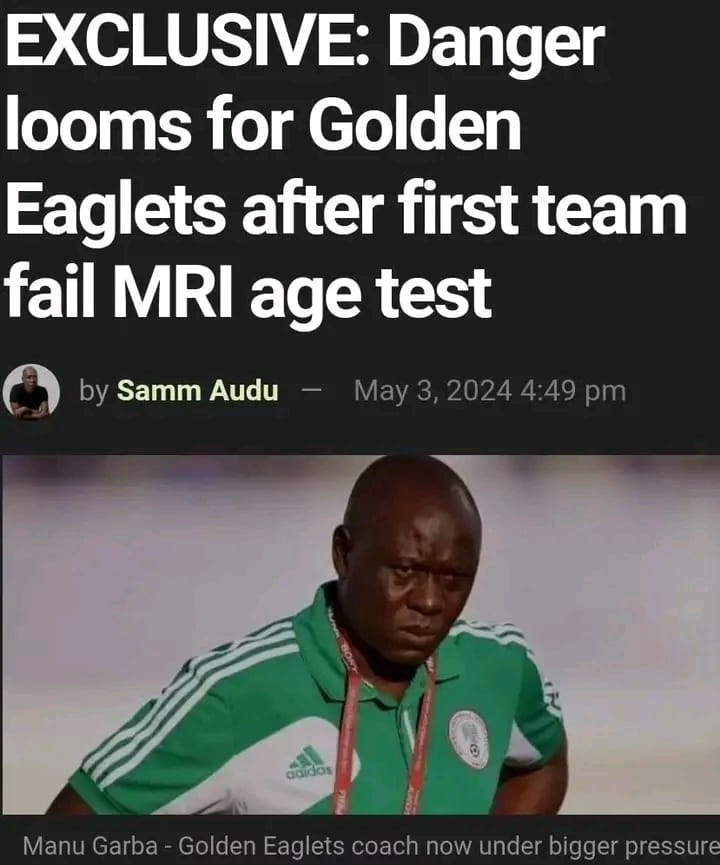Odogwu In Box 18 : At U17, The Fear of MRI, Is The Beginning Of Career

Magnetic Resonate Imaging (MRI) was first introduced to FIFA U17 World Cup in 2007, but it became effective from 2009.
At the U17 World Cup held in Korea 2007, FIFA was only conducting random test of players to ascertain the effectiveness of the MRI to determine the approximate ages of the players presented by participating countries.
In 2009, FIFA U17 World Cup held in Nigeria, the test became effective and compulsory for all participating teams. It became a prerequisite qualification for every player taking part in the tournament.
FIFA had assumed that there are age related issues involving participating countries, especially those from Africa and Asia where date of births are not properly documented.
Before then, many of the winners especially African countries were accused of using over aged players, and MIR or MRI was introduced to at least reduce the age cheat to the minimum.
Magnetic resonance imaging (MRI) is a medical imaging technique that uses a magnetic field and computer-generated radio waves to create detailed images of the organs and tissues in the body.
Most MRI machines are large, tube-shaped magnets. When you lie inside an MRI machine, the magnetic field inside works with radio waves and hydrogen atoms in the body to create cross-sectional images — like slices in a loaf of bread.
MRI is a noninvasive way for a medical professional to examine the organs, tissues and skeletal system. It produces high-resolution images of the inside of the body that help diagnose a variety of conditions.
MRI can be used to examine the brain's anatomy and show which parts of the brain are handling critical functions, language and movements. This information can help guide decisions when considering someone for brain surgery.
MRI also can check for damage from a head injury or from conditions such as Alzheimer's disease.
The MRI scan is a medical imaging procedure that uses a magnetic field and radio waves to take pictures of your body's interior. It is used to investigate or diagnose conditions that affect soft tissue such as tumours or brain disorders.
The strong magnetic field created by the MRI scanner causes the atoms in your body to align in the same direction. Radio waves are then sent from the MRI machine and move these atoms out of the original position. As the radio waves are turned off, the atoms return to their original position and send back radio signals.
The use of magnetic resonance images (MRI) to assess the age of the players would extend diagnostic possibilities. The bone age test could then become a routine screening test.
This idea of changing the method of determining the bone age would also prevent the players from taking a dose of ionizing radiation, making the test less invasive.
The regions of interest containing the wrist area and the epiphyses of the radius are marked on the magnetic resonance imaging of the non-dominant hand of boys aged 9 to 17 years. Textural features are computed for these regions, as it is assumed that the texture of the wrist image contains information about bone age.
The regression analysis to using MRI in determining players age, revealed that there is a high correlation between the bone age of a player and the MRI-derived textural.
However, the experiments performed have shown that using the MRI images give reliable results in the assessment of bone age while not exposing the player to ionizing radiation.
Recently, news went out that higher percentage of players invited to the present U17 team have failed the MRI compulsory. This no doubt, always put pressure on the team, most especially when they have less than seven days to the commencement of their tournament.
As expected, the Head Coach of the team, Manu Garba came out to tell thenff.com that the Golden Eaglets that he heads, is firmly on course to raise a squad capable of doing Nigeria proud at the forthcoming WAFU B U17 Championship in Ghana.
The 2013 FIFA U17 World Cup-winning team lead strategist has told Nigerians to discountenance stories of large failures of Magnetic Resonance Imaging (MRI) tests in his team and rather believe that his crew will put together a squad that will do the job of winning a ticket to next year’s Africa U17 Cup of Nations from the tournament in Ghana.
Quoting his words the former International said “Let me clear the air on this matter. The genuine U17 players, according to their official document made available to the NFF and the MRI tests conducted by the football body are still in the camp preparing for the WAFU B U17 tournament. When the camp opened last month, the very sincere football academies had to withdraw their players after the MRI tests they conducted showed that their players were on Grade 5. These players had to leave the camp immediately.
“Those who were not sincere and thought they could find a way through one way or the other have been exposed after the NFF conducted its own MRI a few days ago, and found the results earlier presented by their players before entering the camp did not tally with the requirements of the NFF. The NFF insists on players whose results are between Grade 1 – 4. Players on Grade 5 have been asked to leave the camp.
The issue now is not telling the players who are Grade 5 and above to leave the camp. The main issue is that the right things are left undone.
If there are proper and adequate developmental programs, these can be avoided. Since keeping proper and adequate data collection and storage is a major national problem, early players identification and grooming can be a away out. Players can be identified from primary schools and groomed until they are of age. The idea of conducting screening for thousands of players with few weeks to a major tournament should be discouraged.
The NFF should approach the issues of grassroots football development with all seriousness. U13 and U15 teams should be a topmost priority. Gathering these players few day to a friendly match should stop. These players should be encouraged further rather than a off thing.
The MRI is now an anathema to youth players and the beginning of their careers.



Write a Comment